Many of us are often more concerned about the dents and dings we see on our cars than the dents and dings we see on our horses. Skin is the largest organ of the body, horse or human. It is a sensory, eliminatory, temperature-regulating, protective organ highly innervated to function for survival. Horses need to be comfortable in their own skin. Dents and dings (watch a VIDEO here) are often indications of past trauma.
“Surface defects” on a horse are commonly thought of as “blemishes” and are usually either ignored or not even seen. I refer to these sites as RedFlags, or the “historical” signs at the site of previous traumas related to deeper soft tissue restrictions. RedFlags may also present as:
- white hairs
- loss of hair
- scars
- abrasions
- saddle rubs
- bubbles
All of these defects should be investigated, as they often are the cause of lingering compensations in posture and movement.
Locating RedFlags
Dent and ding RedFlags are commonly seen on the front of the shoulders, the chest muscles, and at the point the buttocks, as horses get kicked there or bang into objects like fences, stall doors, or trailer posts. Other areas are on top of the pelvis and spinal areas from (ouch!) other horses’ hooves, or rolling on field rocks. The dent actually is retracted scar tissue, most often from a deep bruise (hematoma). As the hematoma resolves and the swelling goes down, we often fail to correlate the dent to the trauma.
RedFlags are myofascial restrictions that need to be found and addressed. You as a horse owner/rider can do this yourself to help improve health, posture, performance and longevity of your horse.
Observe the horse standing quietly and assess the horse’s skin on his body and across his muscles. Is the horse looking tight and tense, or is the horse looking soft, smooth and relaxed? Do you feel restriction under the skin? Is there any heat? Does the horse flinch or tense in certain areas? How does your visual assessment correlate with your gentle palpation?
Use a soft eye and soft hand to stroke the horse’s topline, starting at the poll and moving all the way to the tail. Your horse’s skin should move smoothly under your hand as when you stroke the skin on the back of your own hand. I like to say the skin should give the fluid feel of pushing water off of a glass table.
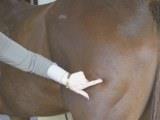
Bubbles are fun! Bubbles are areas over dents that the skin has pulled away from and the space creates a “bubble”. You can see my finger pushing the skin in to dent to find the edges of the scar. As you massage these, the edges and shape will change and often the angle of the pelvis as with this old injury of the biceps femoris (hamstring).
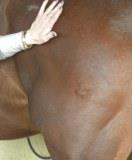
Remedy the RedFlags
My hand is over a muscle that abducts the hip joint and hind leg, gluteus profundus, as well as the lower border of the gluteus medius, which is the big extender and abductor of the hip and lumbar spine. Helps the horse to kick, rear and jump.
- head lowering
- a good head or body shake
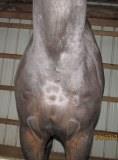
Dents in the front of the shoulder are very common and profoundly affect the entire cervical spine to the poll and TMJ, the shoulder and elbow and often compensations up into the withers. Running into fences can injure both shoulders as the fence rails hit across the front of the chest. Kicks commonly cause many of these traumas and scars.
- deep breaths or sighing
- licking and chewing
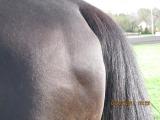
Flat spot or dent on the point of the buttock (the horse’s seat bone) affects the hamstring muscle, which is often tight in horses and humans. Tight hamstrings directly affect the sacroiliac, low back as well as the hock and stifle range of motion. These are often readily improved with soft tissue massage over time.
- yawning
- eye rolling
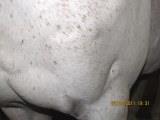
Dents in the area of the chest and shoulder are so very common, Not to be overlooked. Contusions from kicks and bangs will cause deep bruises then deep scarring. Causing restrictions in the shoulder girdle and neck.
- gut sounds
- passing gas or defecating
